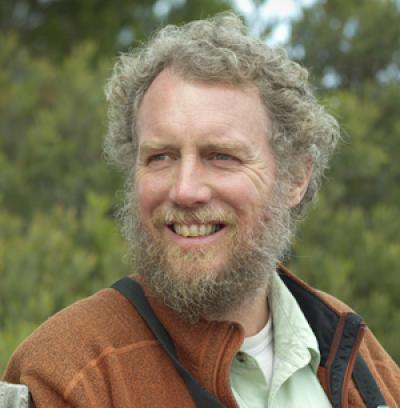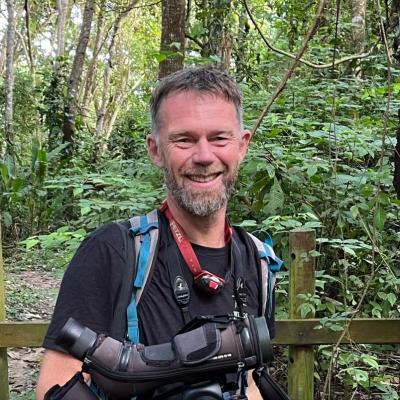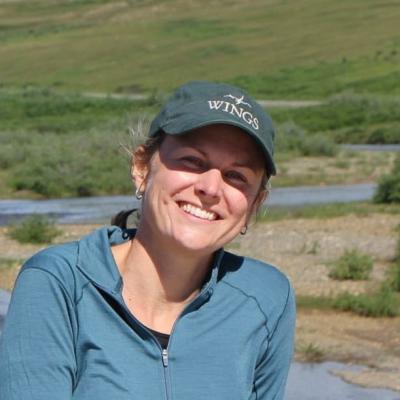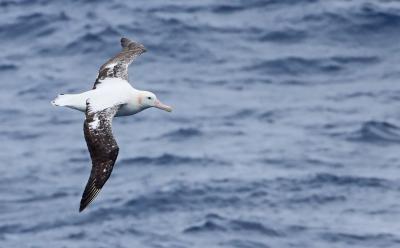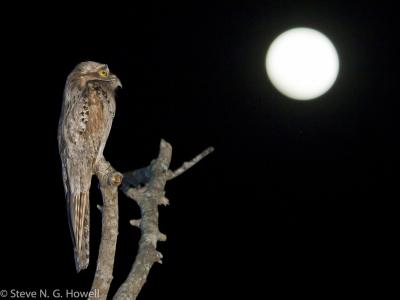Northern Finland and Arctic Norway
-
May 20-31, 2026
Steve Howell and a local leader
-
May 2028
Fabrice Schmitt and a local leader
2026
Single Room Supplement $810
2028
Tour Price to be Determined
2026
Single Room Supplement $810
2028
Tour Price to be Determined
This remarkable tour runs at the optimal time, giving us the best possible chance of finding the northern owls as well as seeing a wonderful collection of other resident species and summer visitors. We’ll begin in Finland, the land of over 180,000 lakes, and the westernmost outskirts of the vast Siberian taiga forest. Many migrant birds will just be arriving at their remote arctic breeding areas.
Finland’s endless birch and pine forest might seem monotonous, but the superficial impression belies a subtle and complex beauty, especially in the patches of old, “untouched” forest. Thick carpets of colorful mosses and lichens line the forest floor, and fantastic old gnarled pines lend a magical character to these places. It may seem as if, by entering such a forest, we have stepped into a fantasy game.
Farther north still, in fact as far as it is possible to go on the European mainland, we’ll visit Norway’s unspoiled Varanger peninsula on the edge of the Barents Sea. Here we’ll experience the full beauty and diversity of arctic birdlife, and we’ll watch many species infrequently seen away from these latitudes.
Day 1: The tour begins this evening in the coastal town of Oulu (pronounced ‘Oh-loo’), Finland. Our hotel is situated right on the Gulf of Bothnia and there is some great birding all around us. Fieldfares and Redwings will be busy feeding young and the adjacent woodland should hold freshly arrived European Pied Flycatchers and numerous Willow Warblers. The reedbeds and scrub will be alive with Sedge Warblers while overhead the drumming display of Common Snipe will fill the evening air. Out on the edge of the bay nesting Northern Lapwings will attack any Hooded Crow that comes too close to their nest, and the sentinel calls of Common Redshank and Black-tailed Godwits may alert us to a passing Marsh Harrier. Night in Oulu.
Days 2 - 3: We’ll spend time looking for some of the most eagerly anticipated of our target birds, the northern owls; Great Gray, Northern Hawk, Ural, Boreal, and Pygmy can all be found in the immediate area. Most will be nesting or feeding fledged young and our hosts have a network of local guides who locate the birds for us. We can also expect to bump into a Short-eared Owl quartering the fields almost anywhere and there is also the chance of Long-eared Owl. In the surrounding fields we’ll look for Ortolan Bunting in the agricultural fields along with smart Whinchats, and these days there is a good chance of finding both Hen and Pallid Harriers as well. Eurasian Woodcocks can be surprisingly common and the hay fields will be alive with nesting waders. We’ll visit a large nature reserve on the edge of the bay where an elevated watchtower will allow us to scan through flocks of Whooper Swans and also scan for our first White-tailed Eagle or a passing Caspian Tern. Around Oulu port we’ll may find Terek Sandpiper which, with only a few breeding pairs remaining in the whole country, is one of Finland’s (and Europe’s) rarest breeding species, while a visit to a small patch of woodland should give us bright Wood Warblers, easily picked up by their shimmering song. Nights in Oulu.
Days 4 - 6: We’ll spend the morning around Oulu before driving to Kuusamo. The forests, bogs and lakes around here support a wealth of birdlife including most of the species we hope to encounter while we are in the north. On the edge of the town there is an excellent location for Little Bunting while a nearby lake will be swarming with Little Gulls, all in smart breeding plumage, as well as our first Arctic Terns and displaying Wood Sandpipers. There will also be a good chance of finding some Ruff, also in breeding plumage. Away from the town we find ourselves in the forested hills of Valtavaara, home to a few pairs of Red-flanked Bluetails which we will take time to locate. Siberian Tit (Gray-headed Chickadee), Siberian Jay and Rustic Bunting are also possible, and any group of crossbills will have to be scanned to see if they are of the Common or Parrot variety!
These forests hold some wonderful game birds but getting a view of them requires patience and luck. We will leave early one morning to drive the many forest tracks hoping to see Capercaillie, Hazel Grouse, or Black Grouse pausing on the roadside or even better, attending a lek. Various lakes and wetlands will be worth scanning for a variety of wildfowl including Taiga Bean Geese, Velvet Scoter, Goldeneye, and Smew and we should see a few pairs of Common Cranes. Nights in Kuusamo.
Day 7: We need to press on northwards, and today we’ll cover some distance, birding along the way, our destination being the town of Ivalo (pronounced ‘Eye-va-low’). We’ll make a brief stop as we cross the Arctic Circle and a series of longer stops at special bogland reserves, where boardwalks give us access to the heart of this beautiful habitat. Here we should encounter handsome Western Yellow (Gray-headed) Wagtails in song, Bohemian Waxwing, Arctic Loon, Peregrine Falcon and if we can find one, Great Gray Shrike. As we get closer to our destination we’ll have chances of finding Eurasian Dotterel and Rock Ptarmigan on the higher ground. Within a few kilometers of our hotel a visit to a local sewage treatment plant should give us our first Bluethroats while a variety of passage waders are possible. We also have an excellent location for Hazel Grouse here if we have missed it so far. Nights in Ivalo.
Day 8: After breakfast, we’ll continue our northward journey, passing through some excellent birding terrain. Made up of a mosaic of taiga forest and bog, the scenery here is very different to anything in the south of the country and is home to very different birds. We’ll make stops to look at gatherings of Ruff performing their extraordinary lekking display, while the sight and sound of displaying Temminck’s Stints, Whimbrels, European Golden Plovers and perhaps the first Long-tailed Jaegers will contribute to the distinctly arctic atmosphere. This is where we’ll have more chances of finding Siberian Jay and Siberian Tit if they have eluded us thus far as both can be elusive at this time of year. We also have an excellent site for the ultra-unobtrusive Pine Grosbeak at a café that puts out bird feeders to attract not only the grosbeaks but also Brambling, Bullfinches, and Common and Hoary Redpolls. We’ll keep an eye open for any geese feeding in the fields as Tundra Bean, Pink-footed and, if we are very lucky, Lesser White-fronted Geese are all possible.
As we head inland, leaving the shores of Varangerfjord behind, we begin to cross the open tundra. Both Long-tailed and Parasitic Jaegers will soon become obvious and we’ll scan for Rock Ptarmigan and Willow Grouse, perhaps picking up Red-throated Pipits, Lapland Longspurs, or Snow Buntings in the process. There will be many pools and small lakes to look over, and we can expect to find lots of Long-tailed Ducks, Greater Scaup, and attractive Arctic Loons, along with a variety of migrant waders, especially Red-necked Phalaropes. We will also search very carefully for Eurasian Dotterel which do breed in the open habitat while the real prize might be a distant Snowy Owl or Gyrfalcon, both rare visitors to the region. Night in Båtsfjord.
Days 9 - 10: Today we retrace our steps across the tundra, searching for anything we may have missed the previous day. We are heading for Vardö at the mouth of the vast Varangerfjord. This whole area will be alive with birds. We’ll look through large gatherings of Herring and Common Gulls for something rarer such as a hulking Glaucous Gull. The bays will be full of Common Mergansers, Black Guillemots, and Common Eider and we’ll search through these for a late, lingering Steller’s Eider although recent years have seen this bird departing its wintering grounds around Vardö earlier and earlier. The same applies to King Eider although we stand a better chance with this species. Yellow-billed Loon is another winter visitor which we hope will still be present.
On one of the days we’ll take a boat trip to Hornöya island. Here the cliffs are teeming with seabirds allowing us to get up close and personal to Common Murres, Razorbills, endearing Atlantic Puffins and the truly arctic Thick-billed Murre. Nights in Vardö.
Day 11: Today we’ll start our return towards Ivalo, retracing our steps across the tundra. We have plenty of time to check any promising birding spots on the way. Night in Ivalo.
Day 12: Depending on flight times there might be chance for some local birding before the tour concludes this morning in Ivalo, Finland.
Note: The information presented here is an abbreviated version of our formal General Information for Tours to Finland and Norway. Its purpose is solely to give readers a sense of what might be involved if they took this tour. Although we do our best to make sure what follows here is completely accurate, it should not be used as a replacement for the formal document which will be sent to all tour registrants, and whose contents supersedes any information contained here.
ENTERING FINLAND AND NORWAY: United States citizens will need a passport which is valid for at least three months beyond intended length of stay. Note: A visa is not required, but two blank pages are required for the entry stamp to each country. Visit the Embassy of Finland website for the most current visa information. Contact the Royal Norwegian Embassy at 2720 34th Street, N.W., Washington, D.C. 20008-2714, Tel: 202-333-6000, or the nearest Norwegian Consulate for the most current visa information. Consulates are located in Houston, Minneapolis, New York City, and San Francisco. Information can also be obtained from the Norwegian Directorate of Immigration website. Citizens of other nations should contact the nearest Finland and Norway embassies for entry requirements.
COUNTRY INFORMATION: You can review the U.S. Department of State Country Specific Travel Information on Finland and Norway at https://travel.state.gov/content/travel/en/international-travel/International-Travel-Country-Information-Pages/Finland.html and at https://travel.state.gov/content/travel/en/international-travel/International-Travel-Country-Information-Pages/Norway.htmlrespectively. You can also read the CIA World Factbook background notes for Finland here, https://www.cia.gov/the-world-factbook/countries/finland/ and Norway, here: https://www.cia.gov/the-world-factbook/countries/norway/.
PACE OF TOUR: Leisurely walking, occasionally over moderately rough terrain, is the only physical requirement, and anybody with a reasonable degree of physical fitness can fully participate in this tour. At one site in Finland we may need to ascend a fairly steep hillside for optimum birdwatching, but this can be done at whatever pace with which the individual feels comfortable – there will be no need to hurry. Our program in Norway includes a ten-minute boat trip to the island of Hornøya, just a short distance off Vardø, where a magnificent seabird colony comprising over 80,000 birds can be viewed at very close range. The trip is made in a very sturdy craft operated by the harbour master and safety is of the highest priority throughout. Since the time on the boat is so short it is unlikely that anyone prone to seasickness will have time to feel unwell, but anyone with an extreme aversion to being on the water may wish to take tablets as a precaution. We usually spend two hours on the island, where basic toilet facilities are available. Because of the extended hours of daylight due to the high latitude there is the potential to be out birdwatching for very long periods. In reality we may have early starts, at around 05.00-05.30 for pre-breakfast excursions, and will occasionally venture out late in the evening to look for more crepuscular species. Most of the owls are actually seen in the daytime! However on these long days besides the usual breaks for meals we do try to arrange adequate rests during the day, where possible. Evening dinners are usually around 20.00, and are followed by the checklist review.
HEALTH: The Centers for Disease Control and Prevention (CDC) recommends that all travelers be up to date on routine vaccinations. These include measles-mumps-rubella (MMR) vaccine, diphtheria-tetanus-pertussis vaccine, varicella (chickenpox) vaccine, polio vaccine, and your yearly flu shot.
They further recommend that most travelers have protection against Hepatitis A.
Please contact your doctor well in advance of your tour’s departure as some medications must be initiated weeks before the period of possible exposure.
The most current information about travelers’ health recommendations can be found on the CDC’s Travel Health website at https://wwwnc.cdc.gov/travel/destinations/list
Smoking: Smoking is prohibited in the vehicles or when the group is gathered for meals, checklists, etc. If you are sharing a room with a non-smoker, please do not smoke in the room. If you smoke in the field, do so well away and downwind from the group. If any location where the group is gathered has a stricter policy than the WINGS policy, that stricter policy will prevail.
Miscellaneous: We will encounter mosquitoes at some places on the tour (mainly in the forests and wooded areas in Finland), which we may find to be distracting. You should therefore bring either aerosol or rub-on insect repellent. If you are particularly sensitive to insect bites, be sure to consult your GP before the trip.
CLIMATE: The weather can be extremely variable at this time of year but nice weather usually predominates. In the south it is likely to be cool and sunny but may change to cloudy with rain or fog very quickly. Temperatures normally vary from 7°C to 20°C (45°F to 68°F) during the day, with only slightly lower temperatures at night. In the north weather is cooler or even cold and at night below-freezing temperatures are normal while daytime temperatures usually vary from 0°C to 10-15°C. (32°F – 60°F). Periods of strong wind, fog and showers are likely in coastal Northern Norway, and you need to dress accordingly.
ACCOMMODATION: Throughout the tour we’ll be staying in comfortable hotels. All rooms will have a private shower and toilet. Internet access is ubiquitous.
FOOD: Normal Western standards. Lunches will be eaten at roadside restaurants or as picnic lunches, according to our preference each day. For most of our meals, we will have buffet or pre-set meals. We will be travelling in some quite remote areas where restaurants are scarce, and where there is often only one option. Buffets are always great, usually offering different kind of meats, fish, vegetarian and gluten-free meals.
Food Allergies/Requirements: We cannot guarantee that all food allergies can be accommodated at every destination. Participants with significant food allergies or special dietary requirements should bring appropriate foods with them for those times when their needs cannot be met. Announced meal times are always approximate depending on how the day unfolds. Participants who need to eat according to a fixed schedule should bring supplemental food. Please contact the WINGS office if you have any questions.
Drinks: Bottled water, a soft drink or a beer (or wine if appropriate) are provided at dinner, as is coffee or tea. Tap water is safe to drink and we suggest bringing a reusable water bottle or canteen to fill up each day.
TRANSPORTATION: Our transport will be minibuses driven by the leaders for maximum flexibility. Participants should be able and willing to ride in any seat in our tour vehicles. Please note the leaders will operate a rotation system for seating in the vehicles.
2024 Narrative
What a fantastic trip! Blessed with wonderful weather during the whole trip, we were very successful having fantastic views of no less than six species of owls, and repeated views of numerous Black Grouses, Capercaillies, Hazel Grouses and two species of Ptarmigans, and we also found many arctic specialties such as Pine Grosbeak, Rufous-flanked Bluetail, Hoary Redpoll, Eurasian Three-toed Woodpecker and Lapland Longspurs. This is a fantastic trip to admire shorebirds in their breeding plumage, displaying and singing: Dunlins, Terek Sandpipers, Broad-billed Sandpipers, Temminck Stints, Eurasian Dotterels, Bar-tailed Godwits, Wood Sandpipers, Common Redshanks, Red-necked Phalaropes just to name a few, even if the most charismatic ones were definitely the colorful Ruffs! Our visit to Hornoya Island with its tens of thousands of breeding seabirds was another highlight of the tour, along with a beautiful adult Yellow-billed Loon in breeding plumage, the smart male Bullfinch, the numerous White-tailed Eagles on the Norwegian coast, and the elegant Long-tailed Jaegers on their nests!
With a beautiful blue sky, no wind and pleasant temperature on arrival in Oulu, we couldn’t resist taking a short walk from the hotel after our intro meeting, to have a look on the nearby reedbed and mudflats. A beautiful male Reed Bunting was singing atop a reed, while a singing Sedge Warbler stayed hidden in the dense vegetation. A pair of Common Snipe was doing its flight display high in the sky, and on the mudflats, we enjoyed our first views of Dunlin in breeding plumage, Ruffs, Common Mergansers and Common Ringed Plovers. A few Willow Warblers were singing here and there, and a singing male Yellowhammer concluded this nice introduction to our tour!
We had two full days to bird the surroundings of Oulu, where the main event is searching for several species of owls. Thanks to the excellent scouting by our Finnish partners, we had fantastic views of Great Gray and Ural Owls on their nest and enjoyed a wonderful close meeting with a very responsive Eurasian Pygmy Owl. We also saw Eurasian Three-toed, Gray-headed and a beautiful pair of Black Woodpeckers, all at their breeding cavity or nearby.
On the shore of the Gulf of Bothnia, we prospected several wetlands, finding shorebirds and other waterbirds in large numbers: Whooper Swans, Northern Shovelers, Northern Pintails, Garganeys, Graylag and Barnacle Geese, Ruffs, Temminck Stints, Common Terns, etc. We even found three rare Broad-billed Sandpipers amongst a few Dunlins and Little Stints and enjoyed a great display by a pair of Terek Sandpipers, here at the western limit of its breeding range.
In the agricultural fields we found Common Cranes, Yellowhammers and Ortolan Buntings, a beautiful male Common Rosefinch, numerous breeding Eurasian Curlews, a few Whinchats, Eurasian Cuckoo and a stunning male Red-backed Shrike. While in the forest, amongst the very common Willow Warblers and Chaffinches, we found Lesser Whitethroats, Greater Spotted Woodpeckers, European Pied Flycatchers, Spotted Flycatchers, Wood Warblers, and Willow Tits.
Leaving Oulu for Kuusamo, we stopped at a small pond where we enjoyed great views of Horned Grebes in their superb breeding plumage, and at a larger lake surrounded by forest where we had nice looks at a pair of breeding Arctic Loons and a male Common Redstart. After checking in at our hotel in Kuusamo, we went for a short after-dinner drive to visit a Boreal Owl nest-box, where we couldn’t have hoped for a better or closer view of this widespread but always difficult to see species!
Around Kuusamo there are plenty of magnificent lakes, surrounded by a coniferous forest that stretches as far as the eye can see, and full of breeding birds: hundreds of Little Gulls (definitely one of the most beautiful gulls in the world) numerous Common Goldeneyes and Common Mergansers, as well as a few Smew, Velvet Scoters, and Tufted Ducks. The Wood Sandpiper also breeds here, and displaying birds were seen and heard everywhere. In the forests, we spotted some fantastic species such as Rufous-flanked Bluetail singing atop some old trees, Eurasian Three-toed Woodpecker drumming on a dead trunk, Gray-headed Chickadee (Siberian Tit in Europe!) and European Siskin, while the Redwing’s song echoed everywhere. We also had great views of some rarer birds, such as Little and Rustic Buntings, as well as a pair of the lovely Gray Wagtail. Now, the main attraction of Kuusamo is definitely the grouse – and we were not disappointed, finding dozens of Black Grouse and 15+ female Capercaillie during our evening drives. We also witnessed the amazing display of Willow Ptarmigan (what a voice!) and even found a Hazel Grouse after hearing its sharp song in the forest understory.
After two full days exploring the area around Kuusamo, it was time to start our long drive towards the North of Norway! On our way, we stopped for one night in Ivalo, where we found two Eurasian Dotterels in beautiful breeding plumage, but also the no less beautiful Bluethroat, of the Northern Europe svecica subspecies showing a reddish spot in the throat. During an after-dinner outing we had a wonderful meeting with the beautiful and ‘angry-looking’ Northern Hawk Owl, and on our way back even found a very cooperative Hazel Grouse, singing and displaying only 30 meters from us!
After Ivalo we stopped at a famous coffee shop where feeders attracted numerous bramblings, together with Common Redpolls, Eurasian Greenfinches and a few Bullfinches. But the stars of these feeders were definitely the dozen Pine Grosbeaks enjoying sunflower seeds just a few meters from us!
Before crossing the border into Norway, we made our first stop in the tundra, finding breeding Long-tailed Jaegers, Willow Ptarmigans, Bar-tailed Godwits, European Golden Plovers, and even a pair of Horned Larks (a rare and interesting sighting as the species is not known breeding in Finland since 2001).
We spent the last part of the trip in the Varanger peninsula in the extreme North of Norway. After the warm temperatures we experienced in Finland, it was now time to wear our warm jackets and gloves while birding these impressive landscapes still mostly covered in snow. Where the snow had already melted, birds such as Rock Ptarmigans, Lapland Longspurs, Long-tailed Jaegers, Dunlins, Northern Wheatears, Hoary Redpolls and Ring Ouzels were displaying and singing actively – what a treat to see such beautiful birds in so amazing landscapes!
Along the coast, we had groups of hundreds of Common Eiders and Common Mergansers, together with Long-tailed Ducks, Red-breasted Merganser and Greater Scaup, all in sparkling breeding plumage. Shorebirds were numerous, and we found a few Curlew Sandpipers and Temminck Sandpipers amongst more common Dunlins, Common Ringed Plovers and Eurasian Oystercatchers. We also found several Ruff leks and couldn’t stop watching the amazing and fun display of the colorful males! In the grassy fields we saw a few groups of Pink-footed and Tundra Bean-Goose, and we counted up to 34 White-tailed Eagles in just one day, many of them perched atop rocks on the shoreline.
At Vardo, where we stayed two nights, we were welcomed by a stunning breeding adult Yellow-billed Loon (but sadly learned that the bird was oiled), hundreds of Black-legged Kittiwakes actually breeding on the city buildings and a dozen Purple Sandpipers foraging on the pier.
One of the highlights here was certainly the morning we spent on Hornoya Island! Hosting 20,000+ pairs of Common Murres, breeding together with Thick-billed Murres, Razorbills, Atlantic Puffins, Black-legged Kittiwakes and European Shags, it was breathtaking to be in the middle of the breeding colony, within just a few meters of these magnificent birds, and surrounded by thousands of flying birds leaving/arriving to the colony. The sound experience was impressive too! And while exploring the grassy slope of the island, we also encountered a few singing Red-throated Pipits and Rock Pipits amongst the more common Meadow Pipits.
It’s always hard to leave such a fantastic place but on our drive back to Finland and Rovaniemi airport for our flight back home, we enjoyed a final display of a few male Ruffs on the shore of a little pond where a few Red-necked Phalaropes in their colorful breeding plumage were swimming around, and we also had a pair of Broad-billed Sandpipers doing a flight display overhead. What a great way to end this great tour!
- Fabrice Schmitt
This tour is offered every other year, on even years.
Maximum group size 10 with two leaders. Both leaders will accompany the tour irrespective of group size.























